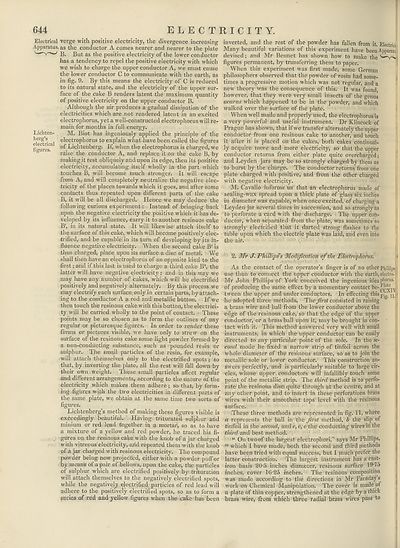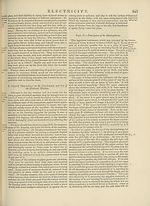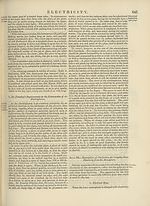Encyclopaedia Britannica > Volume 8, DIA-England
(654) Page 644
Download files
Complete book:
Individual page:
Thumbnail gallery: Grid view | List view

ELECTRICITY.
644
Electrical verge with positive electricity, the divergence increasing
Apparatus, as the conductor A comes nearer and nearer to the plate
B. But as the positive electricity of the lower conductor
has a tendency to repel the positive electricity with which
we wish to charge the upper conductor A, we must cause
the lower conductor C to communicate with the earth, as
in fig. 9. By this means the electricity of C is reduced
to its natural state, and the electricity of the upper sur¬
face of the cake B renders latent the maximum quantity
of positive electricity on the upper conductor B.
Although the air produces a gradual dissipation of the
electricities which are not rendered latent in an excited
electrophorus, yet a well-constructed electrophorus will re¬
main for months in full energy.
Lieliten- M. Biot has ingeniously applied the principle of the
berg’s electrophorus to explain what have been called the figures
figures?1 Lichtenberg. If, when the electrophorus is charged, we
raise the conductor A, and replace it on the cake B, by
making it rest obliquely and upon its edge, then its positive
electricity, accumulating itself wholly in the part which
touches B, will become much stronger. It will escape
from A, and will completely neutralize the negative elec¬
tricity of the places towards which it goes, and after some
contacts thus repeated upon different parts of the cake
B, it will be all discharged. Hence we may deduce the
following curious experiment: Instead of bringing back
upon the negative electricity the positive which it has de¬
veloped by its influence, carry it to another resinous cake
If, in its natural state. It will likewise attach itself to
the surface of this cake, which will become positively elec¬
trified, and be capable in its turn of developing by*its in¬
fluence negative electricity. When the second cake B' is
thus charged, place upon its surface a disc of metal. W'e
shall then have an electrophorus of an opposite kind to the
first; and if this last is used to charge a third cake B", the
latter will have negative electricity; and in this way we
may have any number of cakes, which will be electrified
positively and negatively alternately. By this process we
may electrify each surface only in certain parts, by attach¬
ing to the conductor A a rod and metallic button. If we
then touch the resinous cake with this button, the electrici¬
ty will be carried wholly to the point of contact. These
points may be so chosen as to form the outlines of any
regular or picturesque figures. In order to render these
forms or pictures visible, we have only to strew on the
surface of the resinous cake some light powder formed by
a non-conducting substance, such as pounded resin or
sulphur. The small particles of the resin, for example,
will attach themselves only to the electrified spots; so
that, by inverting the plate, all the rest will fall down by
their own weight. These small particles affect regular
and different arrangements, according to the nature of the
electricity which makes them adhere; so that, by form¬
ing figures with the two electricities in different parts of
the same plate, we obtain at the same time two sorts of
figures.
Lichtenberg’s method of making these figures visible is
exceedingly beautiful. Having triturated sulphur and
minium or red lead together in a mortar, so as to have
a mixture of a yellow and red powder, he traced his fi¬
gures on the resinous cake with the knob of a jar charged
with vitreous electricity, and repeated them with the knob
of a jar charged with resinous electricity. The compound
powder being now projected, either with a powder puff or
by means of a pair of bellows, upon the cake, the particles
of sulphur which are electrified positively by trituration
will attach themselves to the negatively electrified spots,
while the negatively electrified particles of red lead will
adhere to the positively electrified spots, so as to form a
series of red and yellow figures when the cake has been
inverted, and the rest of the powder has fallen from it. Electric:
Many beautiful variations of this experiment have beenApparati
devised; and Mr Bennet has shown how to make the''“’’Y'*
figures permanent, by transferring them to paper.
When this experiment was first made, some German
philosophers observed that the powder of rosin had some¬
times a progressive motion which was not regular, and a
new theory was the consequence of this. It was found,
however, that they were very small insects of the genus
acarus which happened to be in the powder, and which
walked over the surface of the plate.
When well made and properly used, the electrophorus is
a very powerful and useful instrument. Dr Klincock of
Prague has shown, that if we transfer alternately the upper
conductor from one resinous cake to another, and touch
it after it is placed on the cakes, both cakes continual¬
ly acquire more and more electricity, so that the upper
conductor returns from either plate quite overcharged;
and Leyden jars may be so strongly charged by them as
to burst by the charge. The conductor returns from one
plate charged with positive, and from the other charged
with negative electricity.
M. Cavallo informs us that an electrophorus made of
sealing-wax spread upon a thick plate of glass six inches
in diameter was capable, when once excited, of charging a
Leyden jar several times in succession, and so strongly as
to perforate a card with the discharge. The upper con¬
ductor, when separated from the plate, was sometimes so
strongly electrified that it darted strong flashes to the
table upon which the electric plate was laid, and even into
the air.
2. Mr J. Phillips s Modification of the Electrophonis.
As the contact of the operator’s finger is of no other Phillips
use than to connect the upper conductor with the earth,electro-
Mr John Phillips of York conceived the ingenious ideal''101-118,
of producing the same effect by a momentary contact be*^^,
tween the upper and under conductors. In effecting this^- ^
he adopted three methods. The first consisted in raising ‘
a brass wire and ball from the lower conductor above the
edge of the resinous cake, so that the edge of the upper
conductor, or a brass ball upon it, may be brought in con¬
tact with it. This method answered very wrell with small
instruments, in which the upper conductor can be easily
directed to any particular point of the sole. In the se¬
cond mode he fixed a narrow strip of tinfoil across the
whole diameter of the resinous surface, so as to join the
metallic sole or lower conductor. This construction an¬
swers perfectly, and is particularly suitable to large cir¬
cles, whose upper conductors will infallibly touch some
point of the metallic strip. The third method is to perfo¬
rate the resinous disc quite through at the centre, and at
any other point, and to insert in these perforations brass
wires with their smoothest tops level with the resinous
surface.
These three methods are represented in fig. 11, where
a represents the ball in the first method, b the slip of
tinfoil in the second, and c, c, c the conducting wires in the
third and best method.
“ On two of the largest electrophori,” says Mr Phillips,
which I have made, both the second and third methods
have been tried with equal success, but I much prefer the
latter construction. The largest instrument has a cast-
iron basis 20-5 inches diameter, resinous surface IQ'^o
inches, cover 16-25 inches. The resinous composition
was made according to the directions in Mr Faradays
work on Chemical Manipulation. The cover is made of
a plate of thin copper, strengthened at the edge by a thick
brass wire, from which three radial brass wires pass to
644
Electrical verge with positive electricity, the divergence increasing
Apparatus, as the conductor A comes nearer and nearer to the plate
B. But as the positive electricity of the lower conductor
has a tendency to repel the positive electricity with which
we wish to charge the upper conductor A, we must cause
the lower conductor C to communicate with the earth, as
in fig. 9. By this means the electricity of C is reduced
to its natural state, and the electricity of the upper sur¬
face of the cake B renders latent the maximum quantity
of positive electricity on the upper conductor B.
Although the air produces a gradual dissipation of the
electricities which are not rendered latent in an excited
electrophorus, yet a well-constructed electrophorus will re¬
main for months in full energy.
Lieliten- M. Biot has ingeniously applied the principle of the
berg’s electrophorus to explain what have been called the figures
figures?1 Lichtenberg. If, when the electrophorus is charged, we
raise the conductor A, and replace it on the cake B, by
making it rest obliquely and upon its edge, then its positive
electricity, accumulating itself wholly in the part which
touches B, will become much stronger. It will escape
from A, and will completely neutralize the negative elec¬
tricity of the places towards which it goes, and after some
contacts thus repeated upon different parts of the cake
B, it will be all discharged. Hence we may deduce the
following curious experiment: Instead of bringing back
upon the negative electricity the positive which it has de¬
veloped by its influence, carry it to another resinous cake
If, in its natural state. It will likewise attach itself to
the surface of this cake, which will become positively elec¬
trified, and be capable in its turn of developing by*its in¬
fluence negative electricity. When the second cake B' is
thus charged, place upon its surface a disc of metal. W'e
shall then have an electrophorus of an opposite kind to the
first; and if this last is used to charge a third cake B", the
latter will have negative electricity; and in this way we
may have any number of cakes, which will be electrified
positively and negatively alternately. By this process we
may electrify each surface only in certain parts, by attach¬
ing to the conductor A a rod and metallic button. If we
then touch the resinous cake with this button, the electrici¬
ty will be carried wholly to the point of contact. These
points may be so chosen as to form the outlines of any
regular or picturesque figures. In order to render these
forms or pictures visible, we have only to strew on the
surface of the resinous cake some light powder formed by
a non-conducting substance, such as pounded resin or
sulphur. The small particles of the resin, for example,
will attach themselves only to the electrified spots; so
that, by inverting the plate, all the rest will fall down by
their own weight. These small particles affect regular
and different arrangements, according to the nature of the
electricity which makes them adhere; so that, by form¬
ing figures with the two electricities in different parts of
the same plate, we obtain at the same time two sorts of
figures.
Lichtenberg’s method of making these figures visible is
exceedingly beautiful. Having triturated sulphur and
minium or red lead together in a mortar, so as to have
a mixture of a yellow and red powder, he traced his fi¬
gures on the resinous cake with the knob of a jar charged
with vitreous electricity, and repeated them with the knob
of a jar charged with resinous electricity. The compound
powder being now projected, either with a powder puff or
by means of a pair of bellows, upon the cake, the particles
of sulphur which are electrified positively by trituration
will attach themselves to the negatively electrified spots,
while the negatively electrified particles of red lead will
adhere to the positively electrified spots, so as to form a
series of red and yellow figures when the cake has been
inverted, and the rest of the powder has fallen from it. Electric:
Many beautiful variations of this experiment have beenApparati
devised; and Mr Bennet has shown how to make the''“’’Y'*
figures permanent, by transferring them to paper.
When this experiment was first made, some German
philosophers observed that the powder of rosin had some¬
times a progressive motion which was not regular, and a
new theory was the consequence of this. It was found,
however, that they were very small insects of the genus
acarus which happened to be in the powder, and which
walked over the surface of the plate.
When well made and properly used, the electrophorus is
a very powerful and useful instrument. Dr Klincock of
Prague has shown, that if we transfer alternately the upper
conductor from one resinous cake to another, and touch
it after it is placed on the cakes, both cakes continual¬
ly acquire more and more electricity, so that the upper
conductor returns from either plate quite overcharged;
and Leyden jars may be so strongly charged by them as
to burst by the charge. The conductor returns from one
plate charged with positive, and from the other charged
with negative electricity.
M. Cavallo informs us that an electrophorus made of
sealing-wax spread upon a thick plate of glass six inches
in diameter was capable, when once excited, of charging a
Leyden jar several times in succession, and so strongly as
to perforate a card with the discharge. The upper con¬
ductor, when separated from the plate, was sometimes so
strongly electrified that it darted strong flashes to the
table upon which the electric plate was laid, and even into
the air.
2. Mr J. Phillips s Modification of the Electrophonis.
As the contact of the operator’s finger is of no other Phillips
use than to connect the upper conductor with the earth,electro-
Mr John Phillips of York conceived the ingenious ideal''101-118,
of producing the same effect by a momentary contact be*^^,
tween the upper and under conductors. In effecting this^- ^
he adopted three methods. The first consisted in raising ‘
a brass wire and ball from the lower conductor above the
edge of the resinous cake, so that the edge of the upper
conductor, or a brass ball upon it, may be brought in con¬
tact with it. This method answered very wrell with small
instruments, in which the upper conductor can be easily
directed to any particular point of the sole. In the se¬
cond mode he fixed a narrow strip of tinfoil across the
whole diameter of the resinous surface, so as to join the
metallic sole or lower conductor. This construction an¬
swers perfectly, and is particularly suitable to large cir¬
cles, whose upper conductors will infallibly touch some
point of the metallic strip. The third method is to perfo¬
rate the resinous disc quite through at the centre, and at
any other point, and to insert in these perforations brass
wires with their smoothest tops level with the resinous
surface.
These three methods are represented in fig. 11, where
a represents the ball in the first method, b the slip of
tinfoil in the second, and c, c, c the conducting wires in the
third and best method.
“ On two of the largest electrophori,” says Mr Phillips,
which I have made, both the second and third methods
have been tried with equal success, but I much prefer the
latter construction. The largest instrument has a cast-
iron basis 20-5 inches diameter, resinous surface IQ'^o
inches, cover 16-25 inches. The resinous composition
was made according to the directions in Mr Faradays
work on Chemical Manipulation. The cover is made of
a plate of thin copper, strengthened at the edge by a thick
brass wire, from which three radial brass wires pass to
Set display mode to:
![]() Universal Viewer |
Universal Viewer | ![]() Mirador |
Large image | Transcription
Mirador |
Large image | Transcription
Images and transcriptions on this page, including medium image downloads, may be used under the Creative Commons Attribution 4.0 International Licence unless otherwise stated. ![]()
| Encyclopaedia Britannica > Encyclopaedia Britannica > Volume 8, DIA-England > (654) Page 644 |
|---|
| Permanent URL | https://digital.nls.uk/193331507 |
|---|
| Attribution and copyright: |
|
|---|
| Description | Ten editions of 'Encyclopaedia Britannica', issued from 1768-1903, in 231 volumes. Originally issued in 100 weekly parts (3 volumes) between 1768 and 1771 by publishers: Colin Macfarquhar and Andrew Bell (Edinburgh); editor: William Smellie: engraver: Andrew Bell. Expanded editions in the 19th century featured more volumes and contributions from leading experts in their fields. Managed and published in Edinburgh up to the 9th edition (25 volumes, from 1875-1889); the 10th edition (1902-1903) re-issued the 9th edition, with 11 supplementary volumes. |
|---|---|
| Additional NLS resources: |
|

